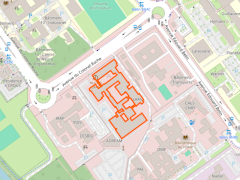Anne Hemeryck
Présentation de mes activités de recherche
Depuis mon recrutement au LAAS-CNRS, mes travaux portent sur le développement et l’application de méthodes de modélisation multiéchelle dédiées à la compréhension des phénomènes physiques et chimiques dans les matériaux, pour des applications en micro- et nanotechnologies. L’objectif est de mettre en place des outils prédictifs capables de compléter les données expérimentales et de guider les procédés technologiques à l’échelle atomique.
Axe central : Interfaces, diffusion atomique, et rôle des défauts
Mon activité de recherche s’articule autour d’un enjeu fondamental : comprendre et contrôler les surfaces et interfaces, où se jouent les mécanismes critiques de diffusion, de réaction chimique et d’évolution structurale. Une attention particulière est portée à la présence et à l’impact des défauts cristallins, qui sont à la fois des perturbations indésirables (en fiabilité) et des leviers technologiques (en quantique).
Thématiques de recherche
1. Défauts et fiabilité des composants électroniques
Les défauts jouent un rôle central dans la dégradation fonctionnelle des matériaux soumis à des conditions extrêmes (irradiation, température, humidité). Mon travail vise à :
- Identifier les mécanismes de formation et d’évolution des défauts sous irradiation (par particules énergétiques ou rayonnement ionisant)
- Évaluer leur impact sur les propriétés électroniques (piégeage de charge, modification de la conductivité, rupture de chaînes fonctionnelles)
- Modéliser la dynamique des défauts et leur clustering, notamment dans des semi-conducteurs pour dispositifs embarqués (applications spatiales et nucléaires)
Ces recherches sont menées en collaboration avec ISAE-SUPAERO (Toulouse), CEA-DAM-DIF (Arpajon), Université de Montréal, et Université de Nova Gorica (Slovénie).
2. Défauts atomiques pour les technologies quantiques à base de silicium
Dans le contexte des technologies quantiques, certains défauts ponctuels dans le silicium peuvent être exploités comme qubits (par exemple des centres de vacance couplés à des dopants). Je m'intéresse à :
- La formation, la stabilité et le contrôle de ces défauts dans des environnements réalistes (interfaces, champs électriques, contraintes mécaniques)
- Leur interaction avec l’environnement électronique et leur potentiel de manipulation cohérente
- Leur intégration dans des architectures compatibles CMOS
3. Croissance des matériaux et nanostructuration des interfaces
La modélisation de la diffusion atomique est essentielle pour comprendre et maîtriser les processus de croissance, d’oxydation ou d’intégration de matériaux hétérogènes. Je développe des approches atomistiques pour décrire :
- L’oxydation thermique du silicium
- La croissance de siliciure
- La croissance de matériau topologique
Ces travaux sont menés avec Nicolas Richard (CEA-DAM-DIF), Sébastien Vizzini (IM2NP), Normand Mousseau (Université de Montréal) et l'équipe MPN du LAAS-CNRS.
4. Capteurs de gaz : de la surface aux propriétés électroniques
Une partie de mes travaux est dédiée à l’étude des couches sensibles pour la détection de gaz, notamment les oxydes métalliques (SnO₂, WO₃, In₂O₃), intégrés dans des capteurs à faible consommation. L'objectif est de comprendre comment :
- Les défauts de surface et de volume influencent la sélectivité et la sensibilité
- Les processus d’adsorption, de chimisorption et de transfert de charge s’organisent à l’échelle atomique
- L’humidité perturbe ou améliore les performances des capteurs
Ces recherches sont menées en collaboration avec Dr. Nicolae Barsan (Université de Tübingen, Allemagne), dans une optique de modélisation prédictive et de rationalisation expérimentale pour des capteurs plus fiables, sélectifs et miniaturisables.












